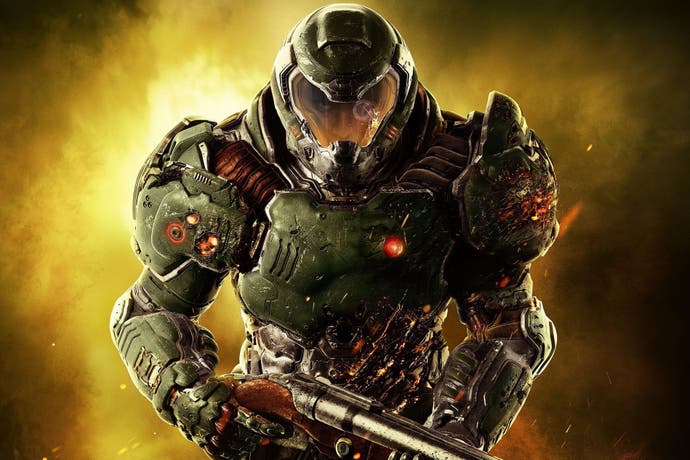Face-Off: Doom
A reinvigorated id software presents a multi-platform tech masterpiece.
There was a time when a new id Software release could make waves across the industry - redefining entire genres, upping the ante for high-end graphics, and changing the face of multiplayer games forever. With those halcyon days lingering in our rear view mirrors over the past few years, it has often felt as if the id Software we grew up with had been lost to time. Then, on Friday the 13th of May, everything changed - Doom was released to the world and blew the doors off expectations worldwide. To say that we were pleasantly surprised would be a vast understatement. To put it simply, id Software is back in a big way and this new take on Doom rockets the studio right back up to the top.
The release of Doom also marks id's triumphant return to cutting-edge graphics engine development. Combining the high performance and virtual texturing capabilities of id Tech 5 with advanced lighting and materials, the new id Tech 6 feels like a long awaited return to form. Such results don't come easy, however - while classic id Tech engines were architected primarily by John Carmack, who has since moved onto Oculus, id Tech 6 is the product of a massive dedicated team of id veterans and leading industry engineers, including a number of folks from Crytek, coming together under one banner.
The results are explosive. Doom delivers a full 60fps shooter on consoles with some of the most remarkable visuals we've seen this entire generation. In the wake of PlayStation Neo rumours and cries for new hardware, the release of Doom and Uncharted 4 in the same month demonstrates just how capable the existing machines are in the right hands. After all, no matter how much power is available, good performance still requires smart coding and design.
What's more impressive is the fact that id has achieved all of this without leaving the PC fan base out to dry. Doom includes a huge number of adjustable options for PC users and crucially, it feels great to play with a mouse and keyboard. id has managed to create something with Doom that manages to feel as if it were crafted specifically for each platform - almost as if it were a high-end first party title. It doesn't really matter which system you own; you're going to have a great experience.
Getting down to the basics, as with id Tech 5 before it, Doom brings a dynamic pixel-count to the table. The idea is simple - adjust the internal rendering resolution based on the load in order to maximise performance. This helps keep the performance up even in the busiest of scenes - the same areas where a drop in resolution will be harder to pick-up visually. This highlights one area where a PS4 exhibits an advantage over Xbox One: it boasts a full 1080p output for the vast majority of the duration, with minor drops in resolution occurring in select circumstances. In contrast, Xbox One regularly struggles to hit full 1080p, more often coming in around 1472x828 or lower.
When it comes to performance, both versions aim to deliver a steady 60 frames per second update and the game comes remarkably close to delivering just that. On PlayStation 4, the majority of battles play out with only the smallest of drops. We've already presented one of the worst-case scenarios in video form, but the overall experience feels perceptually rock solid to the point where we were surprised to find any drops at all after analysing the footage.
On Xbox One, performance isn't quite as robust but it still manages to feel great. During many of the larger battles, frame-rates tumble into the mid-50s with some dips all the way down into the 40s. Again, the general perception is that the experience is smooth, but the drops are more evident throughout. Still, it's a solid effort and one that Xbox One owners will still greatly enjoy. Both platforms offer users the option to adjust FOV and disable motion blur and these settings do have an extremely minor impact on performance but the end results feel similar regardless.

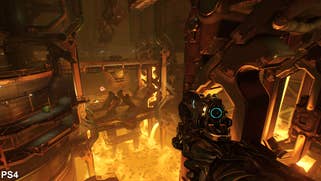
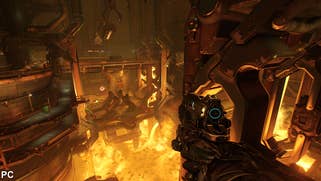

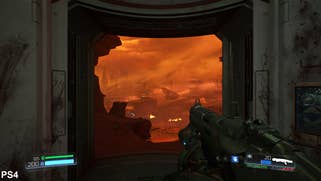
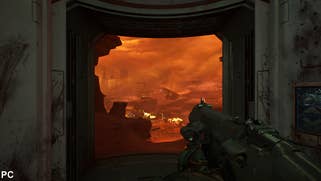

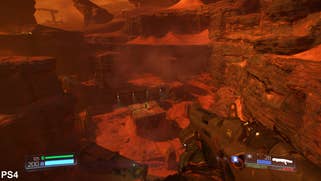
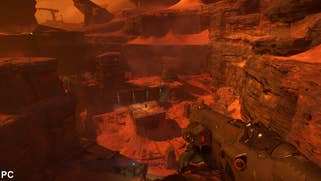
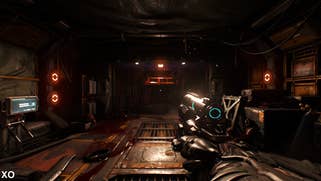
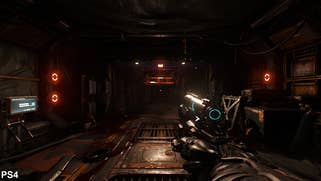
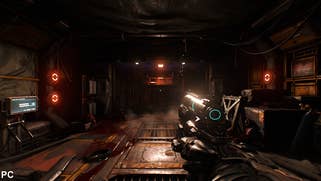
The PC version does not offer any sort of dynamic resolution option, but thankfully, it is possible to manually adjust resolution scaling. Using a 1440p monitor, GTX 970 and R9 290X are both incapable of delivering a full 60fps experience at native resolution. However, knocking the resolution scaling feature down to 85 per cent provides a boost in image quality over 1080p while hitting the desired 60fps target. This is great news here as the game handles scaling better than typical GPU or monitor solutions.
While browsing the options menu, then, you may be surprised by the sheer number of options on offer. The PC version is full of tweakable bits and bobs that enable users to optimise the experience across a wide range of hardware. Despite the wealth of options, many of the changes are actually rather insignificant. So the question becomes, what do these options do and how do the consoles stack up?
Anti-aliasing: Doom introduces a new form of anti-aliasing known as Temporal Super-Sampling Anti-Aliasing, which uses super-sampling to analyse motion data of each frame. This effectively eliminates edge and in-surface aliasing along with distant shimmering to create one of the cleanest examples of AA we've seen as of late, right up there with Uncharted 4. It's a technique present across both consoles versions and included as the default option on PC. It's fast and very effective but PC users are also given the choice of FXAA, SMAA, and TAA with additional temporal pass variants on hand.
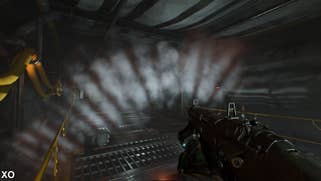
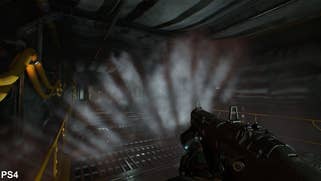
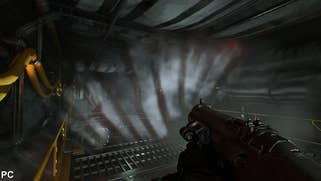
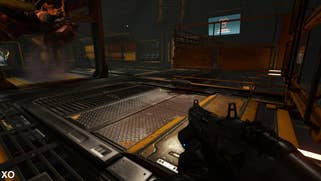
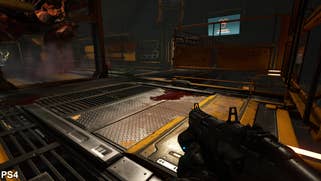
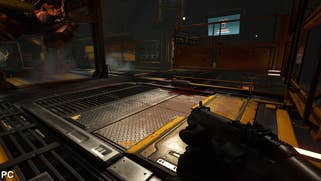
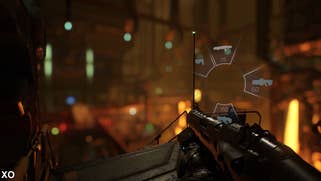
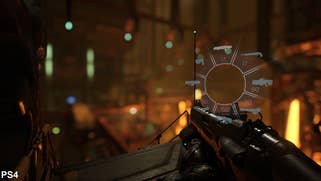
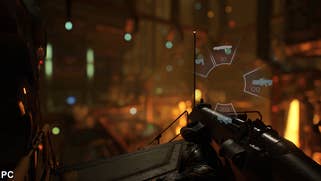
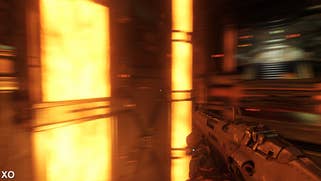
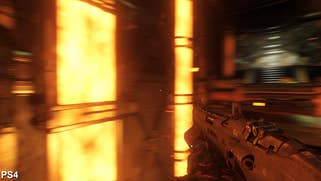
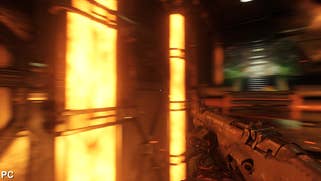
Lights quality: Changing this setting impacts the distance in which point lights become visible. On lower settings, these lights are simply faded from view earlier while, naturally, the highest settings allow you to see each of them from across the map. The console versions both utilise the game's medium setting with lights disappearing from view at a moderate distance from the player.
Shadows quality: This setting determines the resolution of the shadows presented across the world and the distance in which some of them are drawn. The difference between medium and ultra is minimal in terms of visible quality, but when using the medium setting, there are instances in which shadows actually disappear from view. As one might expect, the console versions utilise the medium setting. There is a nightmare setting available on PC, which requires a GPU with 5GB of VRAM and while there is a noticeable boost in shadow clarity over all other settings, it's not something you will miss if you're lacking the memory.
Player self-shadow: This feature allows shadows to play off of the Doom Guy's weapon realistically. It is enabled on consoles and looks very nice in action. That said, it's not something that is visible in all lighting conditions nor does it appear to have a significant impact on performance.
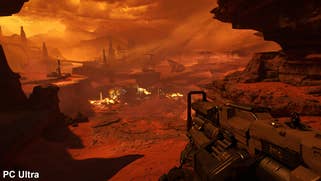
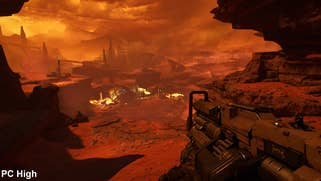
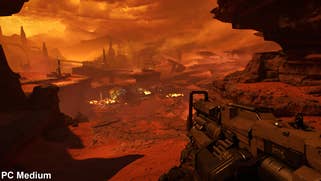
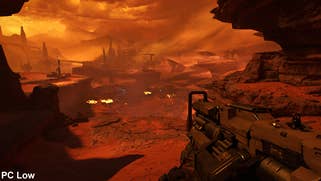


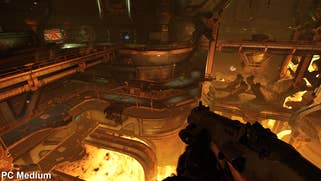
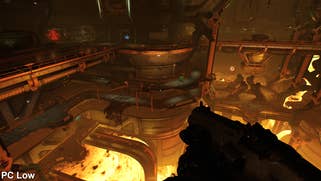


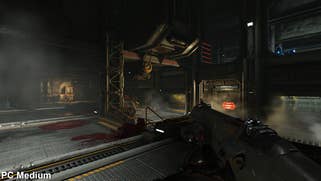
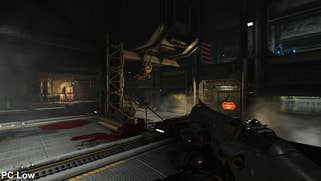


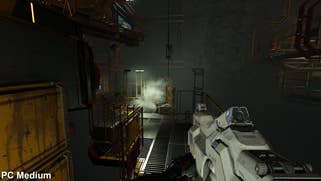

Direction occlusion quality: This is a very high quality approach to ambient contact shadows that works by calculating occlusion and scene illumination dynamically. It brings additional depth to the world that exceeds typical screen-space ambient occlusion methods. Increasing this setting simply improves the accuracy of the effect leading to fewer visible artefacts, but it does manage to look excellent even at medium settings, which is what the consoles appear to use.
Decal quality: The decal system in Doom enables a wide range of surface effects to be painted across the world including the all-important blood splatter and bullet holes. The quality setting appears to control the resolution and density of decals. Using the higher settings enables a much greater number of decals per scene, which are visible further into the distance. The console versions are using the medium setting. The option below it, labeled 'decal filtering', determines the level of anisotropic filtering applied to each decal.
Virtual texturing page size: The page file here serves as a sort of virtual memory pool for the textures. The point of virtual texturing/megatexture is to enable consistency across all versions of the game. For GPUs with less memory available, decreasing the page file size simply means that you'll run into increased texture pop-in but, when textures are fully loaded, quality is still adequate. However, stuttering kicks in if you attempt to push the size of the page file beyond the limits. We're uncertain how large the available page file is for consoles, but we can say that texture pop-in occurs more frequently in these versions than on our 4GB GTX 970, though never to the same degree as previous id Tech 5 games. Textures are slightly less crisp on the consoles as well.
Reflections quality: Doom utilizes a combination of screen-space reflections and cube-maps - at least when using the medium through ultra settings. Consoles appear to use the medium setting, which features slightly less accurate screen-space reflections. On low, screen-space reflections are disabled completely and only cube-maps remain. It's also possible to completely disable all reflections, save for the specular highlights used for point lights.
Particles quality: This determines the resolution and visible distance of particles, such as clouds of dust, smoke, and fire, used in the game. Console versions use the high setting while PC users can push things up to ultra for cleaner effects. What's interesting about the particle system in Doom is that alpha clouds are properly lit and shadowed by the world. Plumes of smoke passing in front of a red light next to a machine will exhibit a red glow, for instance, while shadows filter realistically through steam filled corridors. Doom includes an impressive GPU particle system that is not controlled by this or any setting - it's standard across the board on all platforms for most objects. In certain scenes, such as the foundry, there are actually additional particles in the air visible on the PC when using higher settings.
Compute shaders: This setting takes advantage of additional processing power on the GPU to increase performance of more general purpose tasks. Performing arbitrary processing on the GPU frees up resources on the CPU but it's not entirely clear how this feature is being used in the game as it need not tie into any visible rendering features. It's interesting to see this option available and it likely benefits the consoles in terms of performance due to weaker CPUs.
Motion blur quality: As you would expect, this option controls the sample count and quality of the motion blur used in the game. Even at the lower settings, however, motion blur is of an excellent quality on all three platforms though PS4 boasts a slightly higher quality version of the effect compared to Xbox One. It's also possible to adjust the amount of motion blur as well as disable it completely.
Depth of field: Doom features an absolutely beautiful bokeh depth of field effect that is used when picking up new items, interacting with objects, or swapping weapons around. An option exists for depth of field anti-aliasing as well, but in comparing shots, there does not appear to be any significant difference there. Depth of field is in full effect on consoles, of course.
Those are the primary settings available but there are a few additional options included as well. HDR Bloom, lens flare, and lens dirt, for instance, are all enabled on consoles but can be toggled off on the PC if you prefer to remove the effects from view. HDR Bloom is most visible around lava where an obvious bloom effect is visible with this enabled while lens flare and lens dirt are effects designed to simulate light and dirt playing off of your helmet. It's also possible to play with sharpness and film grain settings.
The PC version also includes a set of rendering modes that influence the appearance of the final image. The default mode presents the game as intended, but gritty and cinematic modes modify contrast, sharpness, and colour grading. It's a setting not unlike that which was available in early Unreal Engine 3 games such as Gears of War and it's a nice touch. Interestingly, Tiago Sousa, lead renderer programmer on the game, suggested that the team fiddled with locking the cinematic mode to 24Hz just for fun but ultimately decided against it as the game suffered.
We were also impressed with the addition of classic maps within the game. Each main level in Doom includes a hidden map from the original Doom or Doom 2, which can be played in its entirety from the main menu. What's fascinating here is that the same models and enemies from the main game are placed into these maps and lighting is all but disabled giving them a unique, flat appearance that you wouldn't normally encounter. Beyond that, we were pleased that textures rendered in these sections are presented using nearest neighbor filtering, giving them a properly pixelated appearance. It's also fascinating to play these maps with the mechanics from the new game - even if you've played through these maps hundreds of times, changing up the mechanics brings an entirely new challenge and it's surprisingly enjoyable.
While we've broken Doom out into its individual components, the truth is, this is a game that is greater than the sum of its parts. You can look closely at certain surfaces or effects and find examples of a game that does it better but there are no other console games that combine all of these elements so beautifully at such a high frame-rate. Doom focuses on the big picture and is stronger for it.
The only area that left us a touch disappointed concerns loading times on consoles. It's not unacceptably long, weighing in between 35 and 40 seconds for each map, but it's the waiting upon death that is the real issue. When you reload a checkpoint, Doom requires users to wait upwards of 20 seconds before returning to the action, which on the higher difficulty modes, feels like an eternity. Now, to be fair, anyone that has played a Dark Souls game on consoles won't have any issues here, but with the speed of the game, we would have loved a faster reload a la Halo 5.
We also ran into some launch day woes with AMD hardware. Doom currently uses OpenGL exclusively, though a Vulkan patch is in the works, and this has often presented an issue for AMD's driver team. Early tests demonstrated that AMD cards were operating at a much lower level of performance but,with the updated Crimson drivers released a few days after launch, frame-rates skyrocketed. We'll be curious to see how Doom runs under Vulkan and we also await the promised SLI support.
Beyond that, however, Doom is a masterpiece both in terms of its technology and its design. The world of shooters has become increasing saturated with bloated open world games with repetitive content, so it's refreshing to play something as exciting and well-made as Doom. It's also a triumph for multi-platform releases in that each version of the game feels crafted for its target machine. While it's true that the PS4 version takes the lead when comparing the two consoles with its faster frame-rate and higher resolution, the Xbox One version is still incredibly well made and looks excellent. No matter which platform you choose, you're bound to have a great time with Doom.
